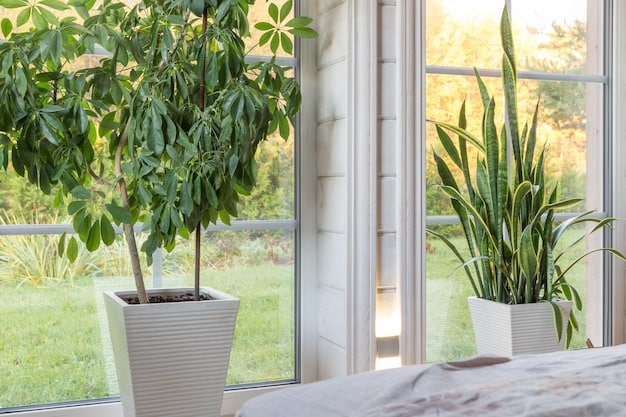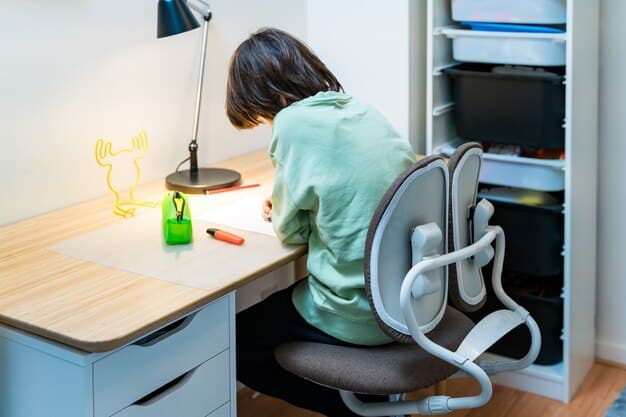Create a Healthy Home Environment: Your Guide to Wellness

Creating a healthy home environment involves optimizing your living space to promote physical and mental well-being through clean air, natural light, comfortable temperatures, and mindful design choices.
Creating a healthy home environment is more than just decorating; it’s about fostering well-being and vitality. Let’s explore practical steps to transform your house into a sanctuary.
Understanding the Importance of a Healthy Home Environment
Your home should be your sanctuary, a place where you can relax, recharge, and feel safe. But sometimes, our homes can inadvertently contribute to health problems. Let’s delve into why creating a healthy home environment is essential for your overall well-being.
A healthy home environment minimizes exposure to toxins and pollutants, promotes good air quality, and supports mental and emotional well-being. It’s about creating a space that nurtures your health rather than detracting from it. Below are some reasons why it’s important.
Reduces Exposure to Allergens and Irritants
Dust mites, mold, pet dander, and other allergens can trigger allergic reactions and respiratory issues. A healthy home environment focuses on minimizing these triggers.
- Regular cleaning and vacuuming to remove dust and allergens.
- Using allergen-proof bedding and covers.
- Controlling humidity levels to prevent mold growth.
Improves Air Quality
Indoor air can be more polluted than outdoor air due to poor ventilation and the release of volatile organic compounds (VOCs) from household products. A healthy home environment ensures better air quality.
- Ensuring good ventilation by opening windows and using exhaust fans.
- Using air purifiers to remove pollutants.
- Choosing low-VOC or VOC-free paints, cleaning products, and furniture.
Supports Mental and Emotional Well-being
A cluttered, disorganized, or poorly lit home can contribute to stress, anxiety, and feelings of overwhelm. A healthy home environment promotes relaxation and mental clarity. It’s about creating a space that feels calming and supportive.
Creating a healthy home involves a holistic approach that considers various factors, from air quality and lighting to décor and organization. Next, we will be looking at practical steps you can take to create a healthier home environment, addressing these key areas.

Improving Indoor Air Quality
Indoor air quality is a critical component of a healthy home environment. Poor air quality can lead to various health issues, including allergies, asthma, and respiratory infections. Here’s how to enhance the air quality in your home.
One of the most effective ways to improve indoor air quality is through proper ventilation. Below are some tips on how to improve your home’s ventilation.
Ensure Good Ventilation
Good ventilation helps remove stale air and pollutants, replacing them with fresh, clean air. However, it’s important to ensure that the outdoor air is also clean.
- Open windows and doors regularly, especially when cooking or cleaning.
- Use exhaust fans in kitchens and bathrooms to remove moisture and odors.
- Consider installing a whole-house ventilation system for continuous air exchange.
Use Air Purifiers
Air purifiers can remove dust, pollen, pet dander, mold spores, and other pollutants from the air. Choose an air purifier with a HEPA filter for best results.
Choose Low-VOC Products
VOCs are chemicals released from many household products, including paints, cleaning supplies, furniture, and flooring. They can cause respiratory irritation, headaches, and other health problems.
- Opt for low-VOC or VOC-free paints, stains, and finishes.
- Use natural cleaning products or those with low VOC content.
- Look for furniture and flooring made from sustainable and low-VOC materials.
In addition to the measures of improving air quality, lifestyle changes can also contribute significantly. For example, avoid smoking indoors and consider using natural air fresheners instead of chemical-based ones. By taking these steps, you can create a home environment that supports respiratory health and overall well-being.
Optimizing Natural Light and Lighting
Natural light is essential for physical and mental health, influencing mood, energy levels, and sleep patterns. Maximizing natural light in your home can create a more vibrant and uplifting atmosphere. Here’s how to optimize natural light and lighting in your living spaces.
Natural light can boost your mood and reduce feelings of depression. Let’s look at ways to maximize the amount of natural light in your home.
Maximize Natural Light
The first step in optimizing natural light is to make the most of what you have. Consider these steps below.
- Keep windows clean to allow as much light as possible to enter.
- Use light-colored curtains or blinds that can be easily opened during the day.
- Trim trees or shrubs that may be blocking sunlight from entering your home.
Strategic Use of Mirrors
Mirrors can amplify natural light, making rooms feel brighter and more spacious. Position mirrors opposite windows to reflect light back into the room. Here are some tips to implement mirrors strategically.
Choose the Right Artificial Lighting
When natural light is limited, supplement it with appropriate artificial lighting. As a result, your home can be brighter at all times.
- Use LED bulbs that mimic the color and intensity of natural light.
- Layer lighting with a combination of ambient, task, and accent lighting.
- Consider installing dimmer switches to adjust the brightness of lights according to your needs.
Optimizing natural light and lighting is about creating a balance that suits your preferences and needs. By maximizing natural light, using mirrors strategically, and investing in appropriate artificial lighting, you can create a home that feels bright, inviting, and conducive to well-being.
Creating a Comfortable and Ergonomic Space
A comfortable and ergonomic home environment is essential for physical health, reducing strain and promoting good posture. Whether you’re working from home or simply relaxing, your furniture and layout should support your body’s needs. Let’s explore how you can create a space that prioritizes comfort and ergonomics.
Ergonomics is the science of designing and arranging workplaces and living spaces to fit the people using them. Creating an ergonomic home environment can help prevent musculoskeletal problems and improve overall comfort. Below are more reasons to create an ergonomic space.
Ergonomic Furniture
Investing in ergonomic furniture is a key step in creating a comfortable and supportive home environment. So, make sure that your body can comfortably relax with the furniture that you have.
Proper Posture and Support
Maintaining good posture is essential for preventing back pain, neck pain, and other musculoskeletal issues. Here are some tips so you can maintain a good posture.
- Use supportive cushions or pillows for your back and neck.
- Adjust your chair to ensure your feet are flat on the floor and your knees are at a 90-degree angle.
- Take frequent breaks to stretch and move around.
Minimize Clutter and Optimize Layout
A cluttered and disorganized space can contribute to stress and discomfort. A clean home will also help you clear your mind and improve your mood. That’s why it is important to make your home clean.
Creating a comfortable and ergonomic space is about tailoring your home to meet your specific needs and preferences. Prioritizing comfort and ergonomics can enhance your physical well-being and make your home a more enjoyable place to live.

Integrating Nature and Plants
Bringing nature into your home can have a profound impact on your well-being. Indoor plants not only purify the air but also add a touch of beauty and serenity to your living spaces. Let’s explore the benefits of integrating nature and plants into your home environment.
Indoor plants purify the air by absorbing carbon dioxide and releasing oxygen. They can also remove toxins such as formaldehyde, benzene, and xylene, which are commonly found in household products.
Choosing the Right Plants
Not all plants are created equal when it comes to air purification. Plants that are known to purify the air more than others include:
- Snake Plant (Sansevieria trifasciata)
- Spider Plant (Chlorophytum comosum)
- Peace Lily (Spathiphyllum wallisii)
Caring for Indoor Plants
Proper care is essential to keep your indoor plants healthy and thriving. When you have healthy plants, they will purify the air more effectively.
- Water plants regularly, but avoid overwatering.
- Provide adequate light according to the plant’s needs.
- Fertilize plants during the growing season.
Nature-Inspired Decor
In addition to plants, incorporating natural elements into your décor can enhance the connection to nature. Here are some nature-inspired décor ideas.
By integrating nature and plants into your home, you can create a living space that is healthier, more vibrant, and more connected to the natural world. The inclusion of plants has been proven to help with mental health, so make sure to have some around the house.
Creating a Relaxing and Mindful Atmosphere
Your home environment should be a sanctuary where you can relax, unwind, and practice mindfulness. By creating a relaxing and mindful atmosphere, you can reduce stress, improve sleep, and enhance your overall well-being. Let’s explore how to transform your home into a haven of tranquility.
Incorporating calming colors into your décor can have a significant impact on your mood and emotions. Soft, neutral colors such as blues, greens, and grays can create a sense of peace and serenity. Dark colors have also been known to help relax when used lightly.
Declutter and Organize
A cluttered and disorganized home can be overwhelming and contribute to stress. If this is something you struggle with, then we can help with some tips to clean your house. Cleaning your house is about decluttering, not getting rid of things.
Create a Meditation or Relaxation Space
Designate a specific area in your home for meditation, yoga, or relaxation. This space should be free from distractions and designed to promote calmness. By being away from distractions, you can relax better and be more aware of your thoughts.
- Use soft lighting and natural elements to create a soothing atmosphere.
- Add comfortable seating, such as floor cushions or a cozy armchair.
- Incorporate calming scents, such as lavender or chamomile.
Creating a relaxing and mindful atmosphere is about designing a space that nurtures your mind, body, and spirit. Through calming colors, aromatherapy, and mindful design, you can transform your home into a true sanctuary of peace and well-being.
Maintaining a Clean and Tidy Home
A clean and tidy home is not only aesthetically pleasing but also essential for health and well-being. Regular cleaning helps remove dust, allergens, and other pollutants that can affect air quality and trigger health issues. Let’s explore how to maintain a clean and tidy home environment.
Below are some tips on decluttering and what you can do to begin in improving your home. By creating habits, you will be able to maintain a clean and tidy home.
Create a Cleaning Schedule
Establishing a cleaning schedule can help you stay on top of household chores and prevent clutter from accumulating. Without habits, it’s going to be hard to maintain a clean home.
- Set aside specific days or times for different cleaning tasks.
- Break down large tasks into smaller, more manageable steps.
Use Natural Cleaning Products
Chemical-based cleaning products can release harmful VOCs and irritate the skin and respiratory system. Opt for natural cleaning products whenever possible such as essential oils.
Involve the Whole Family
Cleaning shouldn’t be a one-person job. Involving all family members in household chores can make the task less daunting and more manageable.
Maintaining a clean and tidy home is about establishing good habits, using natural cleaning products, and involving the whole family in the process. You’ll be able to keep your home a clean environment with these methods listed that can increase your well-being.
| Key Aspect | Brief Description |
|---|---|
| 🌬️ Air Quality | Improve ventilation, use air purifiers, and choose low-VOC products. |
| ☀️ Natural Light | Maximize sunlight, use mirrors, and choose proper artificial lighting. |
| 🌱 Nature | Integrate indoor plants to purify the air and reduce stress. |
| 🧹 Cleanliness | Maintain a tidy and clean environment to reduce allergens and pollutants. |
Frequently Asked Questions
Ventilate your home daily by opening windows for at least 15-20 minutes to ensure fresh air circulation and reduce indoor pollutants. If you live in high-pollution zones, consider using air purifiers.
VOCs (Volatile Organic Compounds) are chemicals released from household products that can cause respiratory irritation, headaches, and other health problems. Choose low-VOC or VOC-free products to minimize exposure.
Snake Plants, Spider Plants, and Peace Lilies are excellent at purifying indoor air by removing toxins like formaldehyde and benzene. They also help regulate humidity levels in your home.
Use an ergonomic chair with good lumbar support, adjust your monitor to eye level, keep your feet flat on the floor, and take frequent breaks to stretch. An ergonomic setup reduces strain and boosts productivity.
Vacuum frequently, especially in areas where your pets spend the most time. Wipe down surfaces regularly to remove pet dander, and consider using air purifiers with HEPA filters to reduce allergens.
Conclusion
Creating a healthy home environment is a holistic endeavor that involves improving air quality, optimizing natural light, fostering comfort, integrating nature, and maintaining cleanliness. By implementing these changes, you can create a home that nurtures your physical and mental well-being, turning your living space into a true sanctuary.





